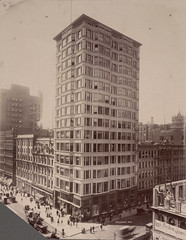The Rise of the Skyscraper

Reliance Building. 1895. Photo courtesy of Cornell University Library
I was fascinated by architectural history long before I moved to Chicago. As a child I amused myself by keeping a running count of Doric vs Ionic capitals on the pillars on front porches throughout town. (So many ways to be a dork. So little time.)
When I came Chicago for graduate school, I found myself in architecture geek heaven. Think Louis Sullivan, Frank Lloyd Wright and, above all, the birth of the skyscraper.
At the end of the nineteenth century, Chicago was a boom town with an expansion problem. The city’s growing business district was hemmed in by Lake Michigan, the Chicago River, and the tangle of railroads leading in and out which had fueled the city’s boom. There was nowhere to go but up.
For centuries, the height of buildings was limited by the ability of the walls to support not only their own weight, but those of the floors above them. The taller the building, the thicker the walls had to be support it. Some of Chicago’s earliest tall buildings, like Burnham and Root’s sixteen-story Monadnock Building (1893), still used masonry load-bearing walls and needed dramatically thickened bases to support the weight of more floors.
The first true skyscrapers left such limitations behind, thanks to two new technologies. The development of skeleton framing and curtain walls, in which a metal frame supports a strong thin outer wall, ended the structural limitations on building heights. Elisha Otis’s invention of the first safe elevator made higher buildings practical as well as possible.
Chicago’s Home Insurance building, constructed in 1884-85, was the first building to use a steel skeleton. Others soon followed. Rapidly adopted by other cities, the skyscraper defined twentieth century America as surely as the cathedral defined medieval Europe.
Just another way to reach toward the heavens.




